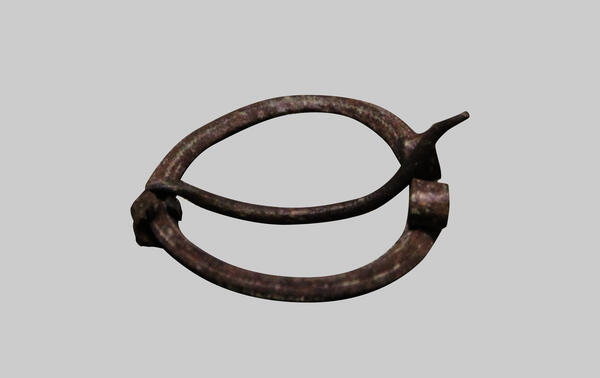The fIbula presented in the exposition was found in the territory of the Township on the LOvat River during the dismantling of a burnt building. It belongs to the early period of the settlement’s existence: the second quarter - the second half of the 10th century. This is one of the earliest among similar finds. Its location is rare: usually fIbulae were dug out in burial places, not within settlements. Outside of ancient Russia, similar fibulae were found in Scandinavia, in the Baltic states and in Finland; all of them date back to the 10th century. Sweden is considered the birthplace of this type of fIbulae.
FIbulae were used to fasten garments. Small fIbulae were used for underclothes, and larger fIbulae were used for the outer garments.
Most of the horseshoe and ring fibulae were made by casting. They were decorated by engraving and minting, with notches and cuts. To decorate them, stamps and punches were used: special steel bars of various shapes and sizes. The simplicity of making horseshoe and ring fibulae ensured their widespread use and longevity.
Horseshoe fibulae with a rhomboid cross section along the entire length were made of iron and bronze.
FIbulae were used to fasten garments. Small fIbulae were used for underclothes, and larger fIbulae were used for the outer garments.
Most of the horseshoe and ring fibulae were made by casting. They were decorated by engraving and minting, with notches and cuts. To decorate them, stamps and punches were used: special steel bars of various shapes and sizes. The simplicity of making horseshoe and ring fibulae ensured their widespread use and longevity.
Horseshoe fibulae with a rhomboid cross section along the entire length were made of iron and bronze.
During excavations, 28 fibulae of this type were found in the Gnezdovsky, Timerevsky and Mikhaylovsky burial grounds, as well as in the Vladimir and Ladoga mounds of the Smolensk Region and near the village of Kiryanovo in the Yaroslavl Region.
In the 1950s, archaeological sites in the south of the Pskov Region were actively studied. The research was carried out by the West Dvina detachment of the Slavic expedition of the Leningrad branch of the Institute for the History of Material Culture of the USSR Academy of Sciences; it was led by Yadviga Stankevich. The employees of the Velikiye Luki Museum of History and Local Lore participated in the research. One of the most interesting monuments of this period is the ancient settlement near the village of Gorodishche in the Pskov Region. Later in scientific literature it was called “Town on the Lovat River”.
The cultural layer of the ancient settlement did not have any significant late destruction layers. This is one of the few monuments subjected to “extensive archaeological excavation on a significant area.” The monument dates back to the second half of the 10th - early 12th century. The town on the Lovat River is located on the right bank of the Lovat River. Some researchers consider it to be the predecessor of Velikiye Luki.
Objects discovered during excavations indicate that the inhabitants of the Town on the Lovat River were mainly engaged in various crafts: iron works, blacksmithing, jewelry and others, as well as trade. Merchants delivered goods here along the Lovat, which, according to the Tale of Bygone Years, was part of the trade route “from the Varangians to the Greeks”.
Close contacts with immigrants from Scandinavia and extensive trade ties explain the wide variety of foreign artifacts. The presented horseshoe fibula is one of them.
In the 1950s, archaeological sites in the south of the Pskov Region were actively studied. The research was carried out by the West Dvina detachment of the Slavic expedition of the Leningrad branch of the Institute for the History of Material Culture of the USSR Academy of Sciences; it was led by Yadviga Stankevich. The employees of the Velikiye Luki Museum of History and Local Lore participated in the research. One of the most interesting monuments of this period is the ancient settlement near the village of Gorodishche in the Pskov Region. Later in scientific literature it was called “Town on the Lovat River”.
The cultural layer of the ancient settlement did not have any significant late destruction layers. This is one of the few monuments subjected to “extensive archaeological excavation on a significant area.” The monument dates back to the second half of the 10th - early 12th century. The town on the Lovat River is located on the right bank of the Lovat River. Some researchers consider it to be the predecessor of Velikiye Luki.
Objects discovered during excavations indicate that the inhabitants of the Town on the Lovat River were mainly engaged in various crafts: iron works, blacksmithing, jewelry and others, as well as trade. Merchants delivered goods here along the Lovat, which, according to the Tale of Bygone Years, was part of the trade route “from the Varangians to the Greeks”.
Close contacts with immigrants from Scandinavia and extensive trade ties explain the wide variety of foreign artifacts. The presented horseshoe fibula is one of them.



